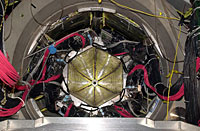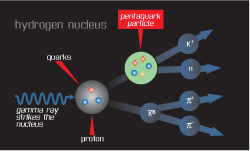|
|
|
|
|
2005 JLab News Release
|
||||||
Pentaquark Debate Heats UpApril 28, 2005New data from Jefferson Lab shows the θ+ pentaquark doesn't appear in one place it was expected. The result contradicts earlier findings in this same region and adds to the controversy over whether research groups from around the world have caught a glimpse of a pentaquark, a particle built of five quarks. 
There are six types of quarks (up, down, charm, strange, top, and bottom). The lightest quarks - called up and down - are the most common. Image: JLab Most ordinary matter is built of combinations of the six kinds, or flavors, of quarks and the corresponding anti-quarks. Quarks are usually found in twos as particles called mesons and in threes as particles called baryons, such as protons and neutrons. Pentaquarks are built of five quarks: for example, the θ+ is built of two up quarks, two down quarks and an anti-strange quark. While this configuration is not theoretically forbidden, finding one would be the first sighting of an exotic baryon. Physicists, who have referred to the many subatomic particles they've discovered as the particle zoo, liken finding a pentaquark to finding a whole new family of animals. The first pentaquark sighting was announced by SPring-8 researchers in the spring of 2003, and the same year, Jefferson Lab, the State Scientific Center Institute for Theoretical and Experimental Physics in Moscow (ITEP) and the ELectron Stretcher Accelerator (ELSA) in Bonn, to name a few, announced that they, too, may have spotted tantalizing hints of the particle in data taken in previous experiments. For instance, evidence from ELSA's SAPHIR collaboration of the θ+ pentaquark came from data they took in 1997/98 and indicated a θ+ pentaquark mass of 1540 MeV. Several experiments since then have backed up these early sightings, while others have failed to confirm them. 
Straight on view of the Hall B detector for CLAS. Photo: Greg Adams, JLab Since many of the positive sightings come from data taken with relatively low statistics, the CEBAF Large Acceptance Spectrometer (CLAS) collaboration in Hall B sought to repeat some of these experiments with higher statistics. The purpose of this experimental program was to provide high quality data to allow physicists to either confirm the pentaquark sightings or rule them out as viable pentaquark candidates. CLAS researchers took data for the g11 experiment May-July in 2004. In the experiment, a beam of electrons was sent into a gold target to produce a beam of high energy photons. These photons were then directed into a liquid hydrogen target. One theory suggested that the θ+ pentaquark may be produced as a photon interacts with the single proton that comprises the hydrogen nucleus. If so, the chain reaction would create a pentaquark, which would exist for a tiny fraction of a second before dissolving into a Kaon (K+) and a neutron. This reaction would also produce a Kaon (K0), which would decay into two pions: a π+ and a π-. The CLAS detector package is capable of detecting the K+ and the two pions, while the mass of the neutron can be inferred from the measurements of the other particles. In a similar experiment conducted by the SAPHIR collaboration at the ELectron Stretcher Accelerator (ELSA) in Bonn, Germany, a signal revealing a pentaquark was observed and reported in 2003. 
It was expected that a pentaquark may be produced when a gamma ray strikes a proton. However, the researchers saw no evidence of the pentaquark. Image: JLab To ensure the best possible analysis, the CLAS collaboration formed three groups to analyze the data independently. The groups spent six months calibrating the data before beginning their analysis. Since the conclusions reached by all three groups were consistent, they decided to present their results in public. One of the analysis groups was lead by Marco Battaglieri and Raffaella De Vita, staff scientists at the Italian Istituto Nazionale di Fisica Nucleare in Genova. Battaglieri presented their group's results to the CLAS collaboration on April 8th, and De Vita presented this preliminary result at the APS April Meeting in Tampa, Florida, on Saturday, April 16. CLAS, whose data contained two orders of magnitude better statistics than the early SAPHIR result, found no evidence of the θ+ pentaquark. The g11 data shows that the particular reaction studied produced no θ+ pentaquarks at a level of precision at least 50 times higher than the published SAPHIR result. Researchers are loath to call the pentaquark an extinct species. The CLAS researchers in this analysis will take another round of data in 2006 to look for a pentaquark produced by a different reaction and at higher energies. And the results aren't in yet for the g10 experiment, which is analyzing data from a pentaquark search performed just before g11's in Hall B. The g10 experiment took data on a deuterium target -- reproducing the original experiment, with higher statistics, that prompted JLab's first announced sighting of a potential pentaquark candidate. The g10 group expects to present their results later this year. Thomas Jefferson National Accelerator Facility’s (Jefferson Lab’s) basic mission is to provide forefront scientific facilities, opportunities and leadership essential for discovering the fundamental structure of nuclear matter; to partner in industry to apply its advanced technology; and to serve the nation and its communities through education and public outreach. Jefferson Lab, located at 12000 Jefferson Avenue, is a Department of Energy Office of Science research facility managed by the Southeastern Universities Research Association. content by Public Affairs maintained by webmaster@jlab.org updated April 27, 2005 |